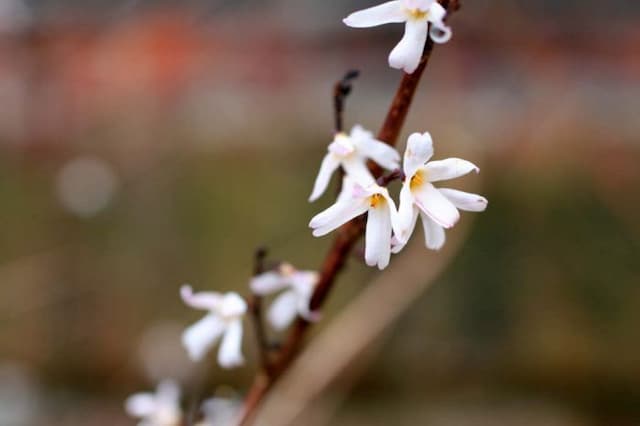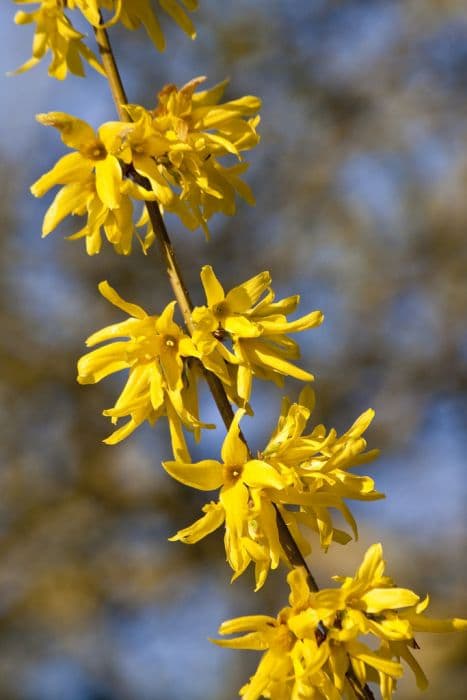Variegated False Holly Osmanthus heterophyllus 'Variegatus' (v)

ABOUT
Osmanthus heterophyllus 'Variegatus', also known as variegated holly olive, is a visually striking plant characterized by its beautiful foliage. The leaves are glossy and have a leather-like texture, featuring a distinctive holly-like shape which is not surprising as it is named for their resemblance to holly (Ilex). They are edged with cream or white variegation, which contrasts sharply with the dark green centers. The variegated pattern is irregular and can vary from leaf to leaf, making each one unique. During the fall, the plant may produce small, white, fragrant flowers that add to its ornamental appeal. These blossoms can sometimes give way to tiny, darkly colored fruits that are of interest to birds but are not considered significant for human use. The overall impression of variegated holly olive is one of elegance and variegated color, with a dense, shrubby form that contributes to its versatility in the landscape as an attractive hedge or specimen plant.
About this plant
 Names
NamesFamily
Oleaceae.
Synonyms
Variegated Holly Olive, Variegated False Holly, Variegated Osmanthus.
Common names
Osmanthus heterophyllus f. variegatus (Carrière) P.S.Green, Osmanthus aquifolium var. variegatus (Carrière) Nakai, Ilex aquifolium var. variegatus (Carrière) Makino.
 Toxicity
ToxicityTo humans
Variegated False Holly is not commonly known as a toxic plant to humans. While there are no significant toxins known in this species that would cause harm if touched or ingested, it is advisable to avoid eating plants that are not specifically grown for consumption, as they can cause stomach upset or allergic reactions in some individuals.
To pets
Variegated False Holly is not widely recognized as toxic to pets. However, as with humans, it is generally not advisable for pets to ingest plants not intended for consumption. If a pet does consume parts of this plant, it could potentially lead to gastrointestinal upset, such as vomiting or diarrhea, due to the plant's rough texture and potential irritants, rather than specific toxins.
 Characteristics
CharacteristicsLife cycle
Perennials
Foliage type
Evergreen
Color of leaves
Variegated
Flower color
White
Height
6 feet (1.83 meters)
Spread
6 feet (1.83 meters)
Plant type
Shrub
Hardiness zones
7
Native area
Asia
Benefits
 General Benefits
General Benefits- Year-round interest: Osmanthus heterophyllus 'Variegatus' offers visual interest throughout the year with its variegated leaves and seasonal flowers.
- Drought tolerance: Once established, this plant is relatively drought-tolerant, making it an ideal choice for gardens with water restrictions.
- Low maintenance: It requires minimal pruning and care, which is beneficial for gardeners seeking plants that do not require constant attention.
- Wildlife attraction: The flowers of Osmanthus heterophyllus 'Variegatus' can attract pollinators like bees and butterflies to the garden.
- Architectural form: This plant can be used as a specimen or in structured designs due to its dense, evergreen foliage and attractive shape.
- Hedging and screening: Its growth habit makes it useful for creating hedges or screens for privacy in gardens or landscapes.
- Versatility in landscaping: This plant is versatile and can be used in a variety of garden settings, including borders, containers, or as a focal point.
- Deer resistance: It's noted to be deer-resistant, which is ideal for areas where deer browsing can be a problem for gardens.
- Tolerance to a variety of soil types: Osmanthus heterophyllus 'Variegatus' can adapt to a wide range of soil conditions, except for extremely wet sites.
- Subtle fragrance: The small flowers produce a delicate and pleasant fragrance that can be enjoyed in the garden during blooming season.
 Medical Properties
Medical PropertiesThis plant is not used for medical purposes.
 Air-purifying Qualities
Air-purifying QualitiesThis plant is not specifically known for air purifying qualities.
 Other Uses
Other Uses- Personal Care Products: Variegated holly olive leaves can be infused into oils and then used to create scented lotions or soaps, providing a unique, subtle fragrance.
- Culinary Flavoring: The flowers of the Variegated holly olive can be used to flavor teas and desserts, although this is more common with other Osmanthus species.
- Decorative Ice Cubes: Flowers from the Variegated holly olive can be frozen into ice cubes to add a floral touch to beverages.
- Natural Dye: The leaves of Variegated holly olive can be used to produce natural green dyes for textiles or craft projects.
- Photography: The plant's striking variegated leaves and seasonally blooming flowers offer an excellent subject for botanical photography and art.
- Garden Barrier: The dense and prickly nature of Variegated holly olive can be utilized as an informal, spiny hedge to deter animals and intruders from gardens.
- Bonsai: Osmanthus heterophyllus 'Variegatus' can be cultivated as bonsai, offering a challenge to enthusiasts with its slow growth and variegated foliage.
- Floral Arrangements: The variegated leaves provide a beautiful contrast in floral arrangements, adding texture and color to bouquets and centerpieces.
- Scented Potpourri: Dried flowers of Variegated holly olive retain their fragrance and can be included in potpourri mixes.
- Craft Material: Leaves and stems can be used in crafting, such as in wreath-making or as natural embellishments for gift wrapping.
Interesting Facts
 Feng Shui
Feng ShuiThe Osmanthus, or False Holly, is not commonly referenced in traditional Feng Shui practice.
 Zodiac Sign Compitability
Zodiac Sign CompitabilityThe Osmanthus is not used in astrology practice.
 Plant Symbolism
Plant Symbolism- Feminine Charm: The delicate and fragrant flowers of the False Holly are often associated with feminine beauty and allure.
- Peace and Positivity: In Eastern culture, osmanthus blooms are a symbol of harmony and the spreading of positive vibes.
- Nobility: Osmanthus is considered a noble plant in Chinese tradition, and is often used in festivals and cultural events to represent dignity and honor.
- Love and Romance: The sweet scent of the False Holly is believed to attract love and enhance romantic feelings.
- Good Luck: Osmanthus flowers are thought to bring good luck and fortune, particularly when given as gifts.
- Perseverance: As a hardy and resilient plant, the False Holly symbolizes the ability to withstand adversity and maintain strength.
 Water
WaterThe Variegated False Holly should be watered deeply and allowed to dry slightly between waterings. Typically, it can be watered once every week, but this may vary based on environmental conditions like heat and humidity. During active growth in the spring and summer, you might need to water more frequently, ensuring that the plant receives approximately 1 to 1.5 gallons during each watering session. In the winter, reduce watering to once every two to three weeks, depending on soil moisture. Always check the top couple of inches of soil for dryness before adding more water.
 Light
LightVariegated False Holly requires bright, indirect light to maintain the variegation in its leaves. It is best positioned in a spot where it can receive filtered sunlight, such as near an east or north-facing window. Direct afternoon sun can be too intense and may scorch the leaves, so if you only have a south or west-facing window, you should use a sheer curtain to diffuse the light.
 Temperature
TemperatureVariegated False Holly prefers moderate temperatures and can tolerate a range from about 20°F to 80°F. However, the ideal temperature for thriving growth is between 60°F and 70°F. It's important to protect the plant from extreme cold and hot temperatures to prevent damage to the foliage and root system.
 Pruning
PruningPrune Variegated False Holly to maintain shape, encourage bushier growth, and remove any dead or damaged branches. The best time for pruning is in the late winter or early spring before new growth begins. Light pruning can be done throughout the year to tidy up the plant. It is not necessary to prune frequently; once a year or as needed to shape the plant is ample.
 Cleaning
CleaningAs needed
 Soil
SoilThe best soil mix for the Variegated False Holly is well-draining, rich, and slightly acidic to neutral in pH, ideally between 5.5 and 7.5. A blend of two parts loam, one part peat moss or well-rotted compost, and one part sharp sand or perlite will create optimal conditions for growth.
 Repotting
RepottingVariegated False Holly should be repotted every 2 to 3 years, best done in the spring. Younger plants might need more frequent repotting, while established, older ones can be repotted less often.
 Humidity & Misting
Humidity & MistingVariegated False Holly thrives at moderate to high humidity levels, somewhere between 40-60% which can often be achieved in normal home environments without extra effort.
 Suitable locations
Suitable locationsIndoor
Place in bright, indirect light and maintain moderate humidity.
Outdoor
Plant in part-shade, shelter from extreme cold and winds.
Hardiness zone
7-9 USDA
 Life cycle
Life cycleOsmanthus heterophyllus 'Variegatus', commonly known as the Variegated Holly Leaf Osmanthus, begins its life cycle when its seeds germinate in the spring, requiring well-drained soil and some warmth. Following germination, the seedling grows slowly, producing variegated leaves that are green with creamy white or yellow edges. As a young plant, it experiences a period of vegetative growth, developing a strong root system and a bushy shape. This evergreen shrub reaches maturity in several years, with mature plants capable of flowering in late summer to autumn, producing small, fragrant white blooms that are attractive to pollinators. After pollination, these flowers may develop into small blue-black berries. The Variegated Holly Leaf Osmanthus has a long lifespan and can survive for many years, with some individuals living several decades, continuing to grow and produce flowers and berries if conditions are favorable.
 Propogation
PropogationPropogation time
Late summer
The most popular method of propagating Osmanthus heterophyllus 'Variegatus', commonly known as Variegated False Holly, is through semi-hardwood cuttings. This type of propagation is typically done in late summer after the flush of growth, ensuring that the stems are mature enough yet pliable. To do this, a cutting of about 4 to 6 inches (10 to 15 centimeters) is taken from a healthy parent plant, stripping the lower leaves to expose a node where roots will form. The cut end of the stem is often dipped in rooting hormone to enhance root development and is then planted in a mixture of potting soil and perlite or sand to ensure good drainage. The cutting should be kept under high humidity and indirect light until roots establish and it can gradually acclimatize to less controlled conditions. It's important to keep the soil moist but not waterlogged to prevent rot. After rooting, which may take several weeks, the new plant can be transferred to a larger pot or the garden.








